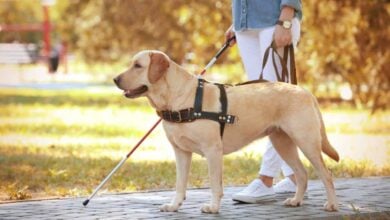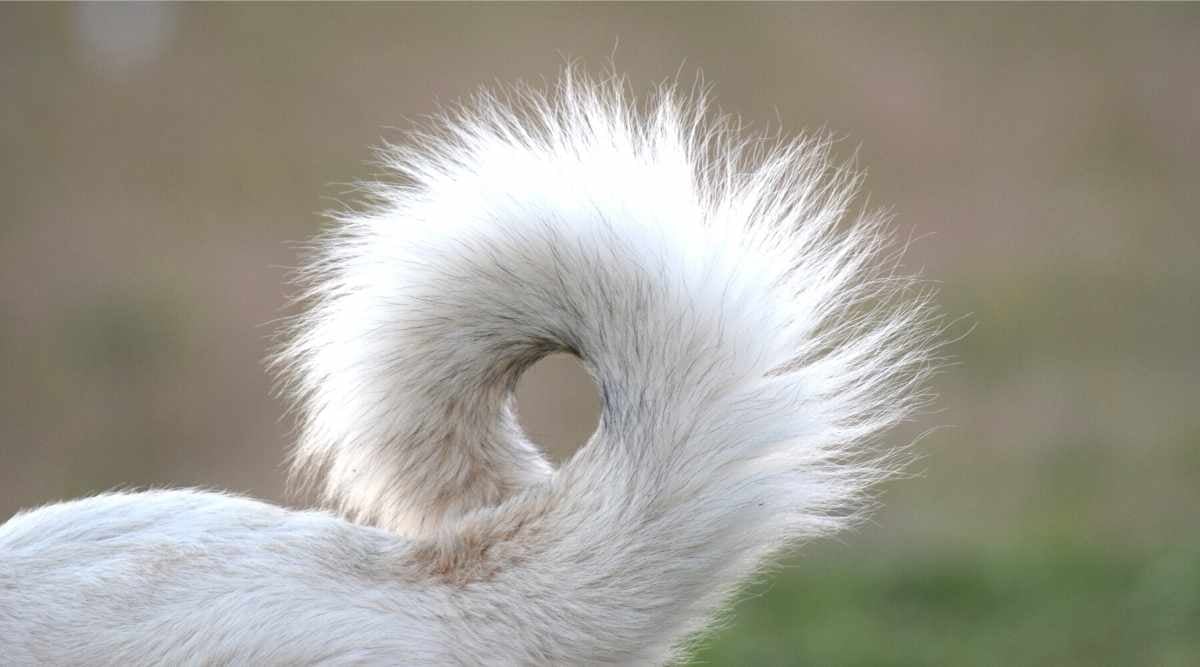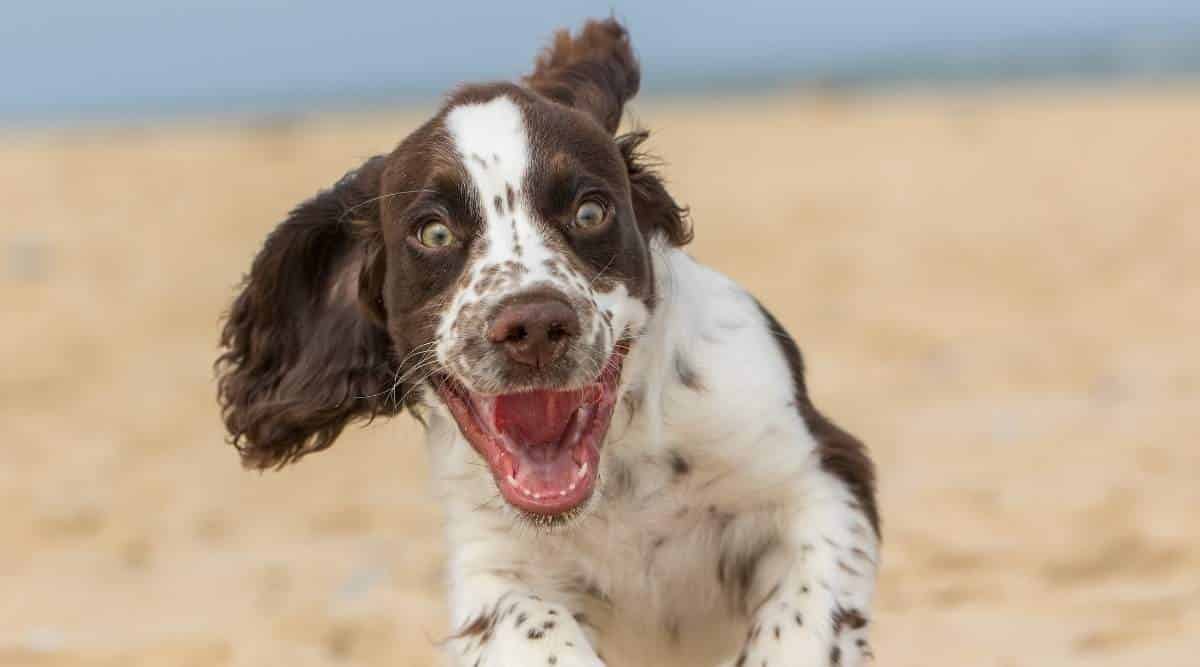Large Dog Breeds: Is Bigger Better?
When you purchase through links on our site, we may earn a commission. Here’s how it works.

When talking about large dog breeds, the first breeds that often come to mind are the Mastiff, the Great Dane, and the Saint Bernard. While these over-sized dogs certainly classify as large dog breeds, there are a variety of other large dog breeds that fall into this category. There is no specific weight or height limit that sets a dog into the large dog breed category. However, in general, a dog that stands at around 26” at the shoulder and/or weighs in at 100 lbs. or more is a dog that fits the bill.
Table of Contents
Some of the breeds of dogs that fall definitively into this category include the Anatolian Shepherd, the Saint Bernard, the Newfoundland, the English Mastiff, the Great Pyrenees, the Great Dane, and the Irish Wolfhound.
Large Dogs Bred To Be Working Dogs
For the most part, large dog breeds were bred to be working dogs, usually used to hunt larger animals, pull heavy carts, or tow fishing nets to fishing boats in frigid waters. As such, working dogs like these breeds developed large and muscular frames to enable them to perform their given tasks with ease. While most of these dogs no longer serve their original purpose, they still maintain the characteristics that allowed them to excel at their work. As such, they all require extreme amounts of exercise as well as mental stimulation to keep them happy and healthy. In general, these breeds are all classified as gentle larges, dogs with sociable demeanors that are both hard-working and family-oriented.
Akbash Dog
The Akbash dog is also known as the Coban Kopegi and is a rare breed native to what is now Western Turkey. This breed made its first appearance around 3,000 years ago when it was bred to guard sheep, and it is believed to be a relative of the Komondor and Kuvasz. This dog stands anywhere from 28 to 32 inches tall and weighs between 90 to 130 lbs. The Akbash has a medium-length double coat that does not matt and is weather resistant. This coat is always white in color. A very muscular breed, the Akbash requires experienced owners who understand how to be a dominant member of the pack hierarchy.
The Akbash is recognized as a “primitive” breed, meaning that it is more accustomed to working solitarily than it is to being a family dog. It is crucial that this dog receive plenty of exercise as well as socialization in order to make sure that the dog is well-adjusted. It is important to note that as a primitive breed, the Akbash is naturally aggressive since it is meant to stand up to flock predators. This is why a dominant and experienced owner is required. The biggest health concern for this breed is hip dysplasia, so it is important to purchase from certified stock. The average lifespan of this breed is around 10 to 11 years.
Akita Inu
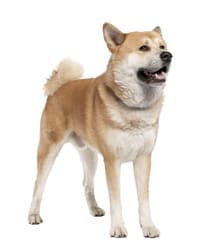 The Akita Inu grows between 24 to 28 inches tall and weighs between 75 and 120 lbs. Female Akitas are almost always shorter and lighter than males. Native to Akita, Japan, this dog has been implemented in a variety of working jobs, including police work, bear hunting, sled dog work, military work, guard dog work, and retrieval work. The Akita breed is considered to be sacred among the people of Japan. It is believed to bring good health and rapid recovery to those who receive its statues as a gift. There are two recognized Akita breeds, the Japanese and the American standard. The differences between these two breeds include coloration. The Japanese standard does not allow for the black mask present in the American standard, and the Japanese measure between 24 to 26 inches tall but have a similar weight range.)
The Akita Inu grows between 24 to 28 inches tall and weighs between 75 and 120 lbs. Female Akitas are almost always shorter and lighter than males. Native to Akita, Japan, this dog has been implemented in a variety of working jobs, including police work, bear hunting, sled dog work, military work, guard dog work, and retrieval work. The Akita breed is considered to be sacred among the people of Japan. It is believed to bring good health and rapid recovery to those who receive its statues as a gift. There are two recognized Akita breeds, the Japanese and the American standard. The differences between these two breeds include coloration. The Japanese standard does not allow for the black mask present in the American standard, and the Japanese measure between 24 to 26 inches tall but have a similar weight range.)
The coat of the Akita Inu is a double coat with a thick but soft undercoat that keeps the dog insulated and a rough, waterproof outer coat that protects the dog from the elements. Colors for the American Akita are various and include pinto, brindle, and white, and all but the white may have a mask. Colors for the Japanese Akita include pure white, sesame, red, fawn, and brindle. The Akita requires vigilant grooming and sheds more heavily twice a year. Akitas are calm and intelligent breeds but can be very hardheaded if not provided with solid leadership. It is important to allow this dog a regular exercise routine not only for physical but also for mental health. The average lifespan for this breed is between 11 and 15 years. Common health concerns for the Akita include hip dysplasia, thyroid conditions, skin conditions, knee problems, immune diseases, and eye conditions.
Anatolian Shepherd
The Anatolian Shepherd generally stands between 29 – 36 inches tall as males and between 69-79 inches tall as females. Anatolian Shepherds can weigh anywhere between 90 – and 150 lbs., with the males generally being larger than females. The Anatolian Shepherd has a thick double coat, which is generally cream-colored with brown patches and is wiry to the touch. The Anatolian Shepherd breed is particularly popular in Turkey, where it serves as an independent livestock guardian, protecting farmer’s flocks of sheep from such predators as wolves, jackals, bears, and cheetahs. As such, the Anatolian Shepherd is a sturdy breed with a particularly thick coat which enables it to survive cold nights out in the fields.
The Anatolian Shepherd is generally thought to live on average between 12-15 years, with the dog usually succumbing to failing joints in old age, heart trouble, or cancer. While 12 – 15 years may not seem like a particularly long life span for such a large breed, it is significantly longer than other large breeds and is thought to be a result of the rugged nature of this dog.
While an accomplished guardian of a flock, the Anatolian Shepherd also tends to be a good guardian of its family. When raised with children and with an understanding of its position in the family, an Anatolian Shepherd can make a good family and guard dog. The Anatolian Shepherd can be rather stubborn, however, and with an inexperienced owner or an owner who is not sensitive to the dog’s exercise needs, the Anatolian Shepherd can become destructive as well as dominant in the household.
Beauceron
The Beauceron is also known as the Berger de Beauce, Bas Rouge, Red Stocking, and Beauce Shepherd. This breed is a French herding breed that has been recorded as far back as 1578. This dog stands between 24 and 27 ½ inches tall and weighs as much as 100 lbs. In general, this breed is both brave and intelligent but must receive adequate stimulation in order to receive enough physical and mental exercise. Without adequate exercise, this breed can be very destructive and turn to herding its human family. The Beauceron has a short double coat with a harsh outer coat and a softer undercoat. This dog can be black with tan markings or may also have patches of gray, black, and tan. Although a generally healthy breed, the Beauceron is prone to hip dysplasia and bloat. The average lifespan of this large breed is between 10 and 12 years.
Belgian Malinois
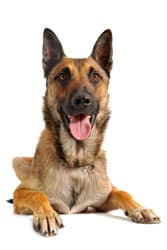 The Belgian Malinois is also known as the Belgian Shepherd Malinois, the Malinois, the Chien de Berger Belge, and the Mechelse Shepherd. Named after the Belgian city of Malines, this breed was bred as a sheepdog and is relatively rare in the United States. This large working dog stands between 22 and 26 inches tall and weighs between 55 and 65 lbs. with females being smaller than males. This breed has a weather-resistant double coat that is straight and short and held closely to the body. Coat colors are fawn, red, mahogany, and black – all hairs have black tips. This breed also has a black mask and ears.
The Belgian Malinois is also known as the Belgian Shepherd Malinois, the Malinois, the Chien de Berger Belge, and the Mechelse Shepherd. Named after the Belgian city of Malines, this breed was bred as a sheepdog and is relatively rare in the United States. This large working dog stands between 22 and 26 inches tall and weighs between 55 and 65 lbs. with females being smaller than males. This breed has a weather-resistant double coat that is straight and short and held closely to the body. Coat colors are fawn, red, mahogany, and black – all hairs have black tips. This breed also has a black mask and ears.
This is a protective and territorial dog that requires socialization and training from an early age. This breed, as with other working dogs, requires plenty of exercise. Although a relatively healthy breed, the Belgian Malinois is prone to skin allergies, disposition concerns, hip and elbow dysplasia, and eye conditions. The average lifespan for this breed is between 12 and 14 years.
Belgian Sheepdog
The Belgian Sheepdog is also known as the Belgian Shepherd, Belgian Shepherd Groenendael, Belgian Groenendael, Chien de Berger Belge, and the Groenendaeler. This breed is a high-energy working dog that hails from Belgium and is one of four known Belgian sheepdogs. This herding and guardian breed stands between 22 and 26 inches tall and weighs between 60 and 75 lbs. This is the most popular breed of all the Belgian Sheepdogs, but it is imperative that you understand what it means to be a leader to your dog when bringing one of these dogs into the home. This is an exceptionally intelligent breed that should be trained and socialized from a very early age.
The Belgian Sheepdog has a weather-resistant coat that is of medium length and has a thicker mane around the neck. Most often, this dog is solid black in coloration but may also have a small amount of white coloration on the chest. The most often seen problems with this large breed include temperament concerns, hip and elbow dysplasia, and obesity. The average lifespan for this breed is between 13 to 14 years.
Belgian Tervuren
The Belgian Tervuren is also known as the Belgian Shepherd Malinois, Tervuren, and Chien de Berger Belge. Like other Belgian sheepdogs, the Belgian Tervuren is a working breed that hails from Belgium, more specifically, the village of Tervuren. This herding breed stands between 22 and 26 inches tall and weighs between 60 and 75 lbs. It is crucial to socialize this breed well and train from an early age as they are instinctively protective and need to be directed and taught appropriate versus inappropriate behavior.
The coat of the Belgian Tervuren is a weather-resistant double coat with long guard hairs and a thick undercoat. Coat colors can be various shades of gray as well as fawn to mahogany. It is not unusual for the coat of this breed to become darker as the dog ages. Minor health concerns for this breed include skin allergies, hip and elbow dysplasia, obesity, eye problems, and epilepsy. The average lifespan of this breed is between 12 and 14 years.
Bernese Mountain Dog
The Bernese Mountain Dog stands between 23 to 28 inches and weighs between 80 to 110 lbs. Females of the breed are most often smaller than the males. Originating in the Swiss Mountains, these working dogs were used to pull carts to market as well as drive cattle and secure family farms. Many of the original traits of this breed still exist today, and these dogs excel in search and rescue, carting, herding, watchdog, tracking, guarding, and competitive obedience work. The Bernese Mountain Dog is considered a member of the AKC working group of dogs and is a Mastiff breed.
This large breed has a thick weather-resistant coat that is tricolor with white, black, and rust coloration. The long coat of this breed requires frequent brushing. This is a seasonally heavy shedder. This is an easy-to-train large breed but does require a good leader in order to become a psychologically healthy dog. The Bernese Mountain Dog does require “family time” with its people and must be well socialized from an early age. In order to keep energy levels and behavior in check, this breed requires regular exercise, which can be tricky during warmer months when the Bernese is overly sensitive to hotter temperatures. The average lifespan of the Bernese Mountain Dog is between 6 to 8 years, much lower than it once was at 10 – 12 years. The most common health conditions for this breed include bloat, cancer, hip and elbow dysplasia, obesity, and eyelid conditions.
Black Russian Terrier
The Black Russian Terrier is not a dog that is commonly seen on the street. This giant breed is a rare find and a powerful dog. The Black Russian Terrier male grows to anywhere from 25 to 29 inches tall, and the female grows to anywhere from 25 to 28 inches tall. These large, solid black dogs can also weigh in at anywhere from 80 to 143 lbs., with the males being considerably larger than the females. The Black Russian Terrier is a strong dog that is recognized for having a good nervous system. The most commonly recognized feature in this Schnauzer-looking dog is the mustache and beard that give the snout of the dog a square appearance.
This terrier is a brave dog that is suspicious of strangers and very protective over its people. The breed is particularly demanding of human contact and requires a strong owner who both values and has a firm alpha position over all animals in the household. This giant breed has a relatively long lifespan of between 10 and 14 years. The most common health problems with this large breed are hip dysplasia, elbow dysplasia, and otitis.
Borzoi
The Borzoi, also known as the Russian Wolfhound, is a dog that was bred by Russian nobility by crossing Sheepdogs with Greyhounds. As a result of this cross-breeding, the breed has a sheepdog-like coat with the body shape of the Greyhound. The long and silky coat of this breed is relatively easy to care for, but it does demand a degree of care. The male Borzoi tends to grow to around 28 inches tall or more, and the females to 26 inches tall. Males will weigh in at around 75 to 105 lbs. and females will weigh in at between 60 and 90 lbs. These deep-chested dogs can be a variety of colors, but commonly, they are tan, black, white, tan, or grey with black markings or golden. These dogs are intelligent and very loyal to their people “pack,” but they do not take well to rough play. That can make them less than desirable as a dog for a family with young children. The Borzoi needs a firm owner who is patient and willing to dedicate time to training. This breed is not as driven to please humans as many other breeds are.
By nature, these dogs are sight hounds and will chase after most things that they see, so they do not do well off-leash and should always be supervised with small pets. The Borzoi is prone to canine bloat and is particularly sensitive to drugs, which can pose problems when veterinary care is needed. This giant breed tends to live for an average of 10 to 12 years.
Briard
The Briard stands between 24 to 27 inches tall and weighs in at around 75 lbs. This breed is recognized by many for its long, wavy coat. The double coat of the Briard features a fine undercoat with a coarse outer coat. Common colors for this breed include grey, tawny, and black. The coat of this breed is fluffy in appearance. Longer hair around the muzzle and eyes gives this dog an old man-type appearance. Naturally a herding dog, it is important to provide socialization and training early for this breed in order to reduce herding behavior with family members and other animals.
A very affectionate and intelligent breed, the Briard is loyal to family and fearless when it needs to be. This dog requires both firmness as well as a gentle hand when being trained. Easily bored, the Briard requires regular exercise and stimulation to prevent troublesome behavior. The average lifespan for this large breed is between 10 to 12 years. Common health concerns for the Briard include hip dysplasia, bloat, progressive retinal atrophy, and cataracts.
Bullmastiff
The Bullmastiff stands between 25 to 27 inches tall and weighs between 100 to 135 lbs. Commonly confused with the English Mastiff, the Bullmastiff has a similar appearance but results from the cross-breeding of the English Mastiff and the old English Bulldog. The Bullmastiff hails from Europe and features a short, dense, and rough coat. The English Mastiff has a short but fine coat. The Bullmastiff is a minimal shedder and does not require frequent grooming. The coat of this breed comes in brown and red coloration. The English Mastiff is silver, black, and tan in color. The Bullmastiff is a quiet but intelligent breed with an independent streak.
Independent yet fiercely loyal to their families, these dogs make great watchdogs. As with all Mastiffs, however, it is crucial for this breed to receive firm and authoritative leadership. Bullmastiffs must be well-socialized from an early age in order to prevent aggression. In order to maintain a well-behaved Bullmastiff, it is also important for this breed to receive regular exercise. Unfortunately, this large breed has a particularly short lifespan of less than 10 years. Frequently seen health conditions in this breed include hip dysplasia, bloating, cancer, eye conditions, obesity, and tumors.
Chesapeake Bay Retriever
The Chesapeake Bay Retriever is also known as the Chessie or the Chessy Dog. This breed began with the mating of Newfoundlands and Retrievers and eventually became a breed of their own used to hunt waterfowl in the Chesapeake Bay. This breed stands between 21 and 26 inches tall and weighs between 55 and 80 lbs. This is not a dog designed for apartment living and has a need for regular exercise. This breed also does not do well in hotter climates. The coat of the Chessie is oily, coarse, and rough. It is also water resistant and has a wave to it. The most common colors for this breed are red, brown, tan, and sedge, and they may sometimes have a small white patch. This breed also has a particular odor to its coat that is distinguishable from other Chessie owners. Unfortunately, this breed is prone to hip dysplasia and eye problems. The average lifespan for this breed is 10 to 12 years.
Dogue de Bordeaux
The Dogue de Bordeaux is also known as the French Mastiff and stands between 23 to 30 inches tall and weighs between 120 to 145 lbs. Much like the Neapolitan Mastiff, this breed has the typical physical characteristics of the mastiff family. The coat of the Dogue de Bordeaux is short but not coarse, and it features loose skin folds, giving it a wrinkled appearance. Dogs of this breed are always a shade of reddish brown that falls between fawn and mahogany. The Dogue de Bordeaux always has a face mask that is black or red in color.
This calm and loyal dog demands an experienced dog owner who can lay down the rules and enforce them. It is also important that this breed be well socialized from a very early age in order to prevent aggressive behavior in adulthood. This large breed demands more daily exercise than the Neapolitan mastiff and must also be provided with plenty of mental stimulation to avoid problem behaviors. This natural watchdog has an average life span of 10 to 12 years. Common health concerns in the Dogue de Bordeaux include hip dysplasia, heart conditions, hyperkeratosis, and epilepsy.
English Mastiff
The English Mastiff is one of the most well-known large breeds of dogs and, in general, stands between 27-30 inches in height. The male English Mastiff can weigh anywhere from 150 – 250 lbs. and the female can weigh anywhere from 120-200 lbs. The English Mastiff was originally bred as a baiting and fighting dog. However, over the years, came to be used in more constructive ways for their size. The English Mastiff has a short and close coat that is apricot-fawn, silver-fawn, fawn, or dark fawn-brindle in color and always has black markings on the face on the muzzle, ears, nose, and around the eyes.
Due to their immense size, the English Mastiff succumbs to quite a few health problems, including hip dysplasia, gastric torsion, and various cancers. The average lifespan of an English Mastiff is between 7-13 years, with most dogs falling at the lower end of the scale due to poor breeding and sheer size. The English Mastiff is generally a good family dog; however, as is the common complaint with similar large breeds, the English Mastiff is known for being clumsy with small children and for drooling excessively. They are, however, generally of good temperament and are gentle.
German Shepherd
The German Shepherd is also known as the Alsatian and the Deutscher Schaferhund. This breed was originally developed in Germany as a herding dog and currently is one of the most popular working dog breeds. The German Shepherd stands between 22 and 26 inches tall and weighs 75 to 85 lbs. This working dog can have a double coat, a plush coat, and a longhaired coat that can come in black and tan, sable, or all-black coloration. Other colors are generally not accepted for this breed. The white German Shepherd is considered a breed of its own. A courageous and alert dog, the German Shepherd is a high-energy breed that requires adequate exercise to avoid destructive behavior. Due to irresponsible breeding patterns, a number of hereditary diseases have become prominent in the German Shepherd breed, including epilepsy, digestive trouble, blood disorders, hip and elbow dysplasia, Von Willebrand’s disease, and degenerative myelitis. The average lifespan for this breed is 13 years.
Giant Schnauzer
The Giant Schnauzer hails from Germany and was primarily used as a police and military dog as well as a cattle-driving dog in Bavaria. This herding breed stands between 23 and 28 inches tall and weighs between 55 and 105 lbs., with the males being larger and heavier than the females. The Giant Schnauzer has a double coat with a softer undercoat and a wiry top coat that is either salt and pepper or solid black in color. These dogs often have longer hair around their whiskers, beards, and eyebrows. These are exceptionally intelligent dogs but can naturally be quite dominant and so require a confident and stern handler. It is crucial that this breed receives plenty of exercise since they are very energetic and need an outlet for that energy in order to avoid behavioral issues. These giant dogs are prone to cancer, bloating, hip dysplasia, and epilepsy. The average lifespan for this breed is between 12 and 15 years.
Great Dane
The Great Dane is certainly known for being one of the tallest large breeds in the dog world. On average, the male Great Dane should measure 30 inches or more at the shoulders, and the female Great Dane should measure 28 inches or more at the shoulders. The male Great Dane should weigh, on average, 120 lbs. while the female should weigh around 100 lbs. This large dog was originally bred for German hunting dogs. However, generally served as house dogs at the time.
These large dogs can have a variety of coat colors, and their short, close coats are generally fawn, brindle, blue, black, harlequin, or mantle in color. While the Great Dane is not known for being a big shedder, it is certainly known for being a big drooler as well as a big leaner. Due to the fact that this is such a large dog that likes to lean, it generally does not do as well in households with younger children since they tend to get knocked down easily. The Great Dane does, however, have a great temperament and is well suited to family life.
Great Pyrenees
The Great Pyrenees is often confused with being a white Newfoundland. However, this large breed is a breed in and of its own. The Great Pyrenees male can stand anywhere from 27-32 inches tall, and the female can stand anywhere from 25-29 inches tall. The male Great Pyrenees weigh on average, anywhere from 110-120 lbs. and the females anywhere from 80-90 lbs. The Great Pyrenees have a thick and fluffy white coat with jet-black eye rims and a nose. The Great Pyrenees dogs were originally bred as shepherd dogs to guard flocks in the Pyrenees Mountains in France and Spain. The white coat of the dog enabled it to guard effectively and remain disguised against the snow, and the thick coat also managed to protect the large dog from the colder temperatures.
In general, the Great Pyrenees live between 10 – 12 years, and despite being hardy dogs, they often succumb to dysplasia from poor breeding or joint and organ wear and tear from the sheer weight of their large frames. The Great Pyrenees, being shepherds by nature, make particularly good family dogs. However, they do not thrive in warm temperatures and are known for being heavy shedders.
Greater Swiss Mountain Dog
The Greater Swiss mountain dog is a large and muscular dog developed from the Roman Mastiff for a number of working jobs. This large breed was commonly utilized as a “horse,” being used as a draft dog in addition to being used for guarding and herding livestock. The greater Swiss mountain dog was also commonly used as the sentinel for farms. This giant dog is classified as a working dog and a mastiff and can grow to anywhere from 23.5 to 28.5 inches. The weight of these incredibly large dogs varies anywhere from 130 to 135 lbs. Like many of the other giant breeds, the greater Swiss mountain dog has a deep chest, which unfortunately leaves it prone to bloating.
This dog is specifically recognized for its unique tri-color coat with a black base and rust and white markings, which are specific to the breed. Even though the greater Swiss Mountain dog is a giant breed, it is an excellent dog when it comes to interacting with children. They are easygoing, sweet, and eager to please. This breed makes an excellent watchdog as they bond quickly with their family and are sensitive to changes in their home. The Greater Swiss of Swissy, as it is sometimes called, has the potential for a number of health conditions, including epilepsy, bloat, hip dysplasia, digestive disorders, and having extra eyelashes. This giant breed has an average lifespan of 10 to 11 years.
Irish Wolfhound
The Irish Wolfhound is a lesser referred to large breed of dog. However, males generally standing between 34-38 inches and females generally standing at 30-35 inches certainly qualify as a large breed! Males weigh between 140 and 180 lbs., and females reach 114 to 140 lbs. This large, wiry-coated breed was originally bred to hunt wolves in Ireland and has been shown in art for years as early as 273 BC. These large but nimble hounds are particularly talented at running and certainly cannot be happy without adequate exercise. The Irish Wolfhound is usually gray, brindle, black, red, white, or fawn in color; however, they are usually dark gray when depicted in the media.
An Irish Wolfhound has a particularly short lifespan, even for a large breed of dog, with lifespan estimates coming in anywhere from between 5-10 years. The Irish Wolfhound generally succumbs to heart defects or bone cancer and is also particularly susceptible to epilepsy. As a family dog, the Irish Wolfhound thrives with contact from its people and is not suited to being left alone for long periods of time. Irish Wolfhounds are unusually aware of their size when young children are present in the household, and they are generally gentle and subdued dogs inside the home.
Kuvasz
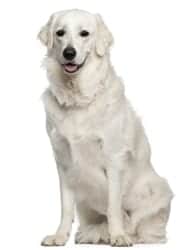 The Kuvasz is another giant breed that is certainly not spoken of as often as many of the more common giant breeds. This giant breed, also known as the Hungarian Kuvasz, actually originated in Tibet but was further developed in Hungary, where it was used as a sheepdog and protector of the flock. The Kuvasz is a fearless dog that can be found with only a white or ivory coat that can be wavy or straight but is always thick. Due to the thickness of this dog’s coat, it does not do well in hot climates. The Kuvasz can make a good family dog, but it is not a dog that can make do with minimal exercise. This giant breed demands an experienced owner who is firm and authoritative, and it is best to have the dog raised around children for the best results as a family dog.
The Kuvasz is another giant breed that is certainly not spoken of as often as many of the more common giant breeds. This giant breed, also known as the Hungarian Kuvasz, actually originated in Tibet but was further developed in Hungary, where it was used as a sheepdog and protector of the flock. The Kuvasz is a fearless dog that can be found with only a white or ivory coat that can be wavy or straight but is always thick. Due to the thickness of this dog’s coat, it does not do well in hot climates. The Kuvasz can make a good family dog, but it is not a dog that can make do with minimal exercise. This giant breed demands an experienced owner who is firm and authoritative, and it is best to have the dog raised around children for the best results as a family dog.
This is an extremely dominant dog, and owners cannot be lax in training them. The male Kuvasz can grow from 28 to 30 inches tall, and the female can grow from 26 to 28 inches tall. The males are also heavier than the females, weighing between 100 and 115 lbs. and the females weigh from 70 to 90 lbs. This large breed can suffer from hip dysplasia, osteochondritis dissecans, hypertrophic osteodystrophy, allergic reactions, and skin problems. The average life expectancy for this giant breed is between 10 and 12 years.
Leonberger
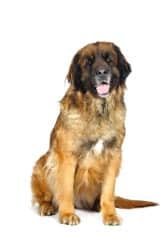 The Leonberger was established as a breed in 1846 as a dog that would resemble the lion in appearance. A popular and versatile German breed, the Leonberger is known for its ability to guard livestock, participate in search and rescue, and work in tracking. This breed is also commonly recognized for its popularity as a family dog. The Leonberger grows between 27 and 31 inches tall and can weigh anywhere from 100 to 170 lbs. The Leonberger is a large, muscular dog with a medium to long thick coat. This double coat is water resistant and can be golden, red, lion yellow, red-brown, pale yellow, cream, or sand, but the dog should always have a black mask. Male Leonbergers have thick manes that develop over the years. Females have much smaller manes. As a giant breed, the Leonberger are avid swimmers and require a long daily walk.
The Leonberger was established as a breed in 1846 as a dog that would resemble the lion in appearance. A popular and versatile German breed, the Leonberger is known for its ability to guard livestock, participate in search and rescue, and work in tracking. This breed is also commonly recognized for its popularity as a family dog. The Leonberger grows between 27 and 31 inches tall and can weigh anywhere from 100 to 170 lbs. The Leonberger is a large, muscular dog with a medium to long thick coat. This double coat is water resistant and can be golden, red, lion yellow, red-brown, pale yellow, cream, or sand, but the dog should always have a black mask. Male Leonbergers have thick manes that develop over the years. Females have much smaller manes. As a giant breed, the Leonberger are avid swimmers and require a long daily walk.
This breed is a naturally brave and affectionate one, and they are known for being entirely devoted to their families. Friendly and trustworthy, these dogs are not great guard dogs. In most instances, they will walk away from situations rather than face them with aggression. Although patient, the Leonberger requires a firm trainer and leader who understands that this breed does not respond to harsh training. The Leonberger is prone to hip dysplasia and bone disease and has an average lifespan of 8 to 9 years.
Native American Indian Dog
The Native American Indian dog is a controversial dog for many because while some claim that this breed is a recreation of the dogs most commonly used by Native Americans, others claim it is a creation of breeders. Regardless, this dog breed has two distinct variations. A long-haired NAID and a short-haired NAID, both of which can range in color, including silver, black, and tortoiseshell coloration. The NAID coat resembles that of a husky or, in the longer-haired breeds, the Sheltie. The NAID grows to around 23 to 34 inches tall and can weigh anywhere from 55 to 120 lbs. A very intelligent breed, the Native American Indian Dog is easy to please its companions and is protective of them at the same time.
This is a particularly sensitive dog breed that should not be trained with a firm hand but rather with an authoritative leader. Socialization is important with any dog, but the NAID is naturally good with children as well as other animals as long as it understands its position within the pack. This breed does not do well living in confined spaces such as apartments, and they also do not do well with crate training because they are “wanderers” by nature. A large yard to play in, daily walks, and off-leash running are great ways to allow this dog to burn off excess energy. The NAID sheds once a year, during which time the coat should be thoroughly brushed. The most common health condition for this large breed is hip dysplasia. The average lifespan of the Native American Indian dog is 14 to 19 years.
Neapolitan Mastiff
The Neapolitan Mastiff stands between 24 and 30 inches tall and weighs as much as 165 lbs. Unlike the Tibetan mastiff, the Neapolitan Mastiff has a much more “mastiff-like” appearance with a smooth coat, wrinkled facial appearance, and large jowls. The coat of this breed is short and dense and can come in a number of different colorations, including tawny, mahogany, chocolate, gray, black, blue, and brindle. The rarest of Neapolitan Mastiff colors is chocolate. As with most mastiff breeds, the Neapolitan Mastiff is a heavy drooler, and as such, it is not the dog for everyone.
While they look vicious, the Neapolitan Mastiff is a very calm and affectionate breed. Simply due to their size, it is important to socialize these dogs well and provide them with dominant leadership. The Neapolitan Mastiff who believes that he or she is a pack leader can have a number of behavioral concerns. These dogs are natural guard dogs and are serious and intelligent by nature. Neapolitan Mastiffs require plenty of exercise but do not thrive in warm weather. Due to their size, these dogs have a particularly short lifespan of around 10 years. Common health concerns include hip dysplasia, bloat, joint pain, and cherry eye.
Newfoundland
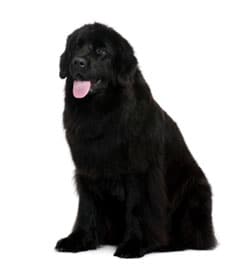 The Newfoundland generally stands at 22 – 28 inches at the shoulder, and males can weigh anywhere between 130 – 150 lbs. and females can weigh anywhere from 100-120 lbs. These large water dogs have particularly thick coats which require daily grooming and are usually black, brown, gray, and landseer in color. Due to the fact that the Newfoundland were bred as fisherman’s dogs to retrieve fishing nets in the freezing waters of Newfoundland, they have particularly thick and water-resistant coats as well as webbed feet. These extremely strong dogs have thick bones as well as large lung capacities as a result of their intended purpose.
The Newfoundland generally stands at 22 – 28 inches at the shoulder, and males can weigh anywhere between 130 – 150 lbs. and females can weigh anywhere from 100-120 lbs. These large water dogs have particularly thick coats which require daily grooming and are usually black, brown, gray, and landseer in color. Due to the fact that the Newfoundland were bred as fisherman’s dogs to retrieve fishing nets in the freezing waters of Newfoundland, they have particularly thick and water-resistant coats as well as webbed feet. These extremely strong dogs have thick bones as well as large lung capacities as a result of their intended purpose.
A Newfoundland finds it hard to resist water even when it is not a working dog, but its jowls, designed to allow the dog to breathe even while in the water, make this another breed that is particularly prone to slobbering. As a result of their immense size, the Newfoundland is also another large breed that is prone to hip and elbow dysplasia as well as heart defects. On average, a Newfoundland has a lifespan of 8-13 years, with most dogs falling at the shorter end of the scale. The Newfoundland does well as a family dog but, as with a Saint Bernard, often knocks down smaller children since it is unaware of its large size and hefty weight. The biggest complaint about the Newfoundland, aside from drooling and clumsiness with smaller children, is their shedding.
Old English Sheepdog
The old English Sheepdog is a recognizable breed for many and stands between 20 to 24 inches tall and weighs anywhere from 60 to over 100 lbs. This breed is a working dog that was developed for sheep herding and cattle driving. Today, this breed is still used for herding as well as for retrieving and watchdog work. Most old English sheepdogs are born tail-less, and for many that aren’t, their tails are amputated (where not forbidden by law.)
The long, shaggy coat of this breed is a double coat with a soft undercoat that protects the skin from water and a rough outer coat. Common coat colors for this breed include blue, grizzle, blue-grey, grey, grey with white markings, blue merle, or white with grey markings. The coat of this breed demands constant attention in order to prevent mattes and skin infections as well as parasites. Many people who own pet old English Sheepdogs have their dogs shorn every few months to help with coat maintenance. This large breed is particularly active and requires a significant amount of exercise in order to keep in shape. It is also necessary that this dog receive leadership from a strong human leader. The average lifespan of this breed is between 10 and 12 years. Common health conditions that affect this dog include hip dysplasia, anemia, and a genetic sensitivity to certain drugs.
Otterhound
The Otterhound is believed to be a French breed in origin and is so named due to the fact that they were used to prey on otters that were stealing fish from local rivers. This large breed grows to between 24 and 26 inches tall and weighs between 66 and 115 lbs. The Otterhound is known for having an exceptional sense of smell as well as a rough, shaggy coat. The outer coat is rough, but the undercoat is water-resistant and soft. The coat of the Otterhound can come in a variety of colors, including grizzle and wheaten with black markings. This is another breed recognized for having the appearance of having shaggy eyebrows.
This breed has webbed feet and is known for being particularly strong swimmers who will even dive when looking for a perceived prey item. Although the Otterhound can give the appearance of being a calm companion, it does require a consistent and determined owner in order to avoid behavioral issues. The Otterhound requires plenty of daily exercise as well as regular grooming in order to prevent the matting of the fur. Health concerns for the Otterhound include hemophilia, bloating, hip dysplasia, and thrombocytopenia. The average lifespan for this breed is between 10 and 12 years.
Plott Hound
The Plott Hound is a breed with American ancestry that resulted from the breeding of Bloodhounds and curs in North Carolina. A little smaller than some other large breeds, the Plott Hound tops out at around 24 inches tall with a minimum height of 20 inches. This breed weighs between 45 and 55 lbs., but this can also vary greatly based on height and breeding. The Plott Hound’s coat is short and glossy and can range from a single to a double coat, depending upon breeding. The most common coloration for this breed is a brindle black and brown coloring, but they can also be solid black, brindle with a black saddle, buckskin, and black with a brindle trim.
These dogs make great hunters as well as companions but require early socialization and obedience training from a confident handler. This breed requires plenty of exercise and is known for drooling like many hounds are. The Plott Hound is prone to bloating and has an average lifespan of 12 to 14 years.
Rhodesian Ridgeback
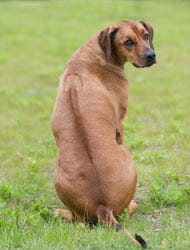 The Rhodesian Ridgeback is native to Zimbabwe, where they worked as guard dogs and hunters. Once the dog was introduced to Rhodesia, it became known for its ability to hunt big game, such as lions, which is how it also became known as the African lion hound. This hound is a very muscular dog with a long tapering tail and a short coat that features a ridge along the back where the fur grows in the opposite direction of the rest of the coat. The Rhodesian Ridgeback’s color varies and includes lighter wheaten colors to darker shades of red.
The Rhodesian Ridgeback is native to Zimbabwe, where they worked as guard dogs and hunters. Once the dog was introduced to Rhodesia, it became known for its ability to hunt big game, such as lions, which is how it also became known as the African lion hound. This hound is a very muscular dog with a long tapering tail and a short coat that features a ridge along the back where the fur grows in the opposite direction of the rest of the coat. The Rhodesian Ridgeback’s color varies and includes lighter wheaten colors to darker shades of red.
While known for its hunting ability, the Ridgeback is a calm family dog that is both gentle and obedient. These dogs must be handled by strong and confident owners who can enforce the rules of the home. Without appropriate handling, the Ridgeback can be stubborn, but with a good master, it will learn quickly. It is important to socialize this breed from an early age and to be consistent in obedience training. This is a very energetic breed and requires daily runs as well as intellectual stimulation to prevent problem behavior. While few dogs are known for being more destructive than bored Labradors, Rhodesian Ridgebacks are not given enough stimulation! Although a hardy breed health-wise, the Ridgeback is susceptible to cysts, hip dysplasia, and dermoid sinus. The average lifespan for this breed is between 10 to 12 years.
Rottweiler
Bred in the German town of Rottweiler, this large, heavily built breed had many applications, including police work, messenger dog work, guard dog work, herding, and draught dog work. This mastiff breed has a smooth and glossy coat that is rough to the touch and is always black with mahogany markings on the legs, paws, muzzle, and cheeks. It is also possible to have a red Rottweiler with brown markings. However, these are seldom seen over their black and mahogany counterparts. This muscular dog stands between 22 and 27 inches tall, weighs between 85 and 130 lbs. and requires plenty of exercise. Daily walks for this breed are a must in addition to other “playtime” activities to burn off energy.
The Rottweiler requires a natural leader willing to begin training and socialization early on in order to develop a dog with a well-rounded personality. The Rottweiler is prone to entropion, snoring, hip dysplasia, ACL damage, and overeating (obesity.) The average lifespan for this breed is between 10 and 12 years.
Saint Bernard
The Saint Bernard is a well-known large breed following the movie series “Beethoven.” This large breed generally stands anywhere from 27 to 35 inches tall, with the females generally measuring on the lesser end of the scale. Saint Bernard’s can weigh anywhere from 140 to 260 lbs., again with the females of the breed weighing in at the smaller end of the scale. Saint Bernard has a particularly thick coat, which can be flat or rough, and is a red-brown and white mixed color with black markings on the face. The Saint Bernard has a thick, long tail. In general, the Saint Bernard breed was bred as a mountain dog whose job was to rescue mountaineers from avalanches. When they are portrayed in the media, a Saint Bernard generally has a barrel of brandy around its neck, which is supposed to warm avalanche victims. On average, the Saint Bernard breed has a lifespan of 8 years, which is not uncommon for large dog breeds.
In general, the larger a dog breed, the more strain is put on their joints and organs to support the weight of the body. Unfortunately, due to their size, the Saint Bernard is prone to hip and elbow dysplasia. Their size also poses a problem to them being family dogs. While the Saint Bernard is a gentle and family-oriented dog, it does not particularly realize its size and strength and often knocks down small children. The biggest complaint about the Saint Bernard breed is their clumsiness with smaller children or their slobbering habit, which can be found with many of the large dog breeds.
Saluki
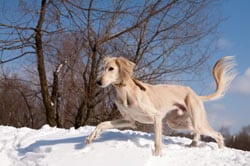 The Saluki is also recognized as the Persian Greyhound. This breed requires a lot of exercise in order to maintain both physical and psychological fitness. It is important not to let this sighthound off leash at any time due to their chasing instinct. The Saluki was bred as a sight hunter and was frequently utilized as a hunter of antelopes and hares in rough desert terrain. This slender dog has a Greyhound-type build with a deep chest and a long neck. This breed has a short coat that features longer silky hair on both the ears and tail. Common coat colors for the Saluki include white, black, tan, grizzle and tan, golden, cream, and fawn. The Saluki breed can grow to anywhere from 23 to 28 inches tall and can weigh anywhere from 29 to 66 lbs.
The Saluki is also recognized as the Persian Greyhound. This breed requires a lot of exercise in order to maintain both physical and psychological fitness. It is important not to let this sighthound off leash at any time due to their chasing instinct. The Saluki was bred as a sight hunter and was frequently utilized as a hunter of antelopes and hares in rough desert terrain. This slender dog has a Greyhound-type build with a deep chest and a long neck. This breed has a short coat that features longer silky hair on both the ears and tail. Common coat colors for the Saluki include white, black, tan, grizzle and tan, golden, cream, and fawn. The Saluki breed can grow to anywhere from 23 to 28 inches tall and can weigh anywhere from 29 to 66 lbs.
This breed is a very devoted one that tends to attach itself to a single leader who should be firm but gentle in teaching obedience. This breed is easily distracted and requires consistent leadership. This is a sensitive dog that does not do well with roughhousing that younger children can sometimes bring. This dog is a good watchdog breed. As an instinctive hound, they should not be trusted with smaller animals. This breed is prone to cancer as well as genetic eye diseases. It is also important to know that the Saluki is easily sunburned and should be protected from direct sun exposure. The average lifespan of this breed is 10 to 12 years.
Scottish Deerhound
The Scottish Deerhound stands between 28 to 32 inches tall and weighs between 75 to 110 lbs. With a similar body shape to the Greyhound, this large breed was at one time the dog of royals. In Scotland, no one with less than an Earl’s title was permitted to own one of these hounds. These dogs were bred for and used to hunt deer for a long period of time until guns were invented. Numerous times throughout its history, the Scottish Deerhound has been close to extinction.
Today, the breed has managed to maintain its existence and is renowned for its sense of sight and its sense of smell. Some of the activities that these dogs are known to excel in today include tracking, sighting, agility, racing, hunting, and lure coursing. The Scottish Deerhound is a gentle and sociable dog that requires consistent and firm leadership to overrule their natural hardheadedness.
The coat of the Scottish Deerhound is wiry and is shorter in length on the chest, head, and belly. This dog comes in grey, blue, grey, yellow, sandy red, red fawn, brindle, and black. The coat of this dog is wiry and needs to be groomed regularly to avoid knotting. Due to the wiry nature of the hair, this dog is an average shedder. This is a breed that demands a regular exercise schedule and a stern but calm owner. The average lifespan of this breed is under ten years. Health concerns that face this breed most commonly include bloat and epilepsy.
Spinone Italiano
The Spinone Italiano is a lesser-known large breed of dog that is also known as the Italian Pointer. This breed is still not too common in the United States; however, it is frequently seen in Italy, where it is used as an all-around hunting dog. The Spinone Italiano excels at retrieving and recovering wild game due to its incredible sense of smell. This breed stands between 22 ½ to 27 ½ inches tall and weighs anywhere from 61 to 85 lbs.
The Spinone Italiano has a thick, wiry coat that comes in a variety of colors, including white with brown markings, orange roan, orange roan with orange markings, white, white and orange, brown roan, and brown roan with brown markings. This is an incredibly strong dog that is both intelligent and easygoing. This breed excels with children as well as other animals; this friendly nature makes this a poor breed choice for those looking for a protective dog breed. It is crucial that this breed understand its position within the family hierarchy in order to be a well-rounded dog. Hip dysplasia can be a concern with this dog, as can cerebellar ataxia. The average lifespan of this breed is 12 years.
Standard Poodle
The Standard Poodle has a somewhat mysterious origin with no real record of the country of origin. Many people say that this is a water retrieval dog that hails from Germany. The Standard Poodle is very fond of the water but has also been used as a gun dog. The standard poodle can have a curly or corded coat that comes in a number of solid colors, including white, brown, black, blue, apricot, red, silver, and gray. A large part of the poodle’s coat is the clip given by professional groomers. This breed can measure in at anything over 15 inches tall and can weigh between 45 and 70 lbs.
The Standard Poodle is a cheerful dog and does not have extreme exercise requirements. It is important, however, to give this breed adequate exercise daily in order to avoid the dog becoming highly strung. This breed requires a firm but calm leader and excels as a family-oriented dog. Despite being a long-lived breed, the Standard Poodle is susceptible to a variety of health conditions, including bloat, Von Willebrand’s Disease, cataracts, allergies, hip dysplasia, and runny eyes. The average lifespan for this breed is between 12 and 15 years.
Tibetan Mastiff
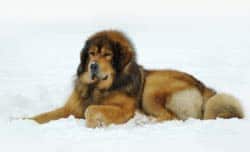 The Tibetan Mastiff stands between 25 to 28 inches tall and weighs between 140 and 170 lbs. Despite being named “mastiff,” these dogs look considerably different than many of the other dogs that bear this name. Most notably, the Tibetan Mastiff has a thick double coat that makes the dog appear much larger than it actually is. This double coat is particularly thick around the dog’s neck and gives it the appearance of having a mane. These dogs come in blue-gray, brown, or black with various colored markings. Originally used in the Himalayan Mountains, these dogs are built for colder weather.
The Tibetan Mastiff stands between 25 to 28 inches tall and weighs between 140 and 170 lbs. Despite being named “mastiff,” these dogs look considerably different than many of the other dogs that bear this name. Most notably, the Tibetan Mastiff has a thick double coat that makes the dog appear much larger than it actually is. This double coat is particularly thick around the dog’s neck and gives it the appearance of having a mane. These dogs come in blue-gray, brown, or black with various colored markings. Originally used in the Himalayan Mountains, these dogs are built for colder weather.
The Tibetan Mastiff makes a great guard dog as well as a livestock guardian, but it is a strong-willed dog that demands an experienced and firm owner to give it leadership. These dogs do well as family dogs but require regular exercise as well as regular grooming. While good dogs for allergy sufferers, the Tibetan Mastiff will “blow” its coat twice a year, and during this time, it must be brushed daily to remove dead and shedding hair. The average lifespan of this dog is around 15 years old, and common health concerns include hip dysplasia, canine inherited demyelinative neuropathy, skin conditions, and ear infections.
Tosa
The Tosa is a Japanese breed that was unfortunately bred as fighting dogs when the sport was popular and legal in the country. This is not a common breed in the United States and has been banned in a number of countries due to the use of the breed in dog fighting in illegal dog fighting rings. When handled and trained well, this breed can make a great family companion as well as a great watchdog. This member of the Mastiff family grows to around 24” tall and weighs around 80 to 200 lbs. Variations in weight seem to stem from U.S. and Japanese breeds of this dog. A very muscular breed, the Tosa has a short, thick coat that is brindle, solid, or multicolored. Multicolored coats are fawn, apricot, black, yellow, black and tan, black and brindle, or red in color. Often, this dog also has a black mask.
Despite being known as a fighting breed, the Tosa is a sensitive dog when it comes to training and requires a firm and authoritative leader who is also calm in nature. Socialization and training must begin as early as possible for this breed in order to ensure that the dog is well-trained. The Tosa can have problems with other animals in the home, so early animal socialization is also crucial. This breed requires a long daily walk or jog to burn off excess energy and avoid obesity. The Tosa breed is prone to bloating, hip and elbow dysplasia, and genetic eye conditions. The average lifespan for this breed is around 10 to 12 years.
Vizsla
The Vizsla is also known as the Hungarian Pointer and was originally developed as hunters used for hunting rabbits and waterfowl. The Vizsla has a short coat that is a variety of gold shades. It is common practice for this breed to have a docked tail. Today, tail docking has been outlawed in many areas. The Vizsla grows to between 20 and 26 inches tall and weighs between 40 and 60 lbs. This is a gentle dog that requires a patient but firm leader and plenty of exercise. This breed is particularly active, and as such, it may not make the best companion for homes with smaller children. Without an appropriate level of exercise, the Vizsla can become extremely destructive. In particular, they are noted for being chewers. The Vizsla is prone to hip dysplasia and has an average lifespan of between 12 and 15 years.
Weimaraner
The Weimaraner is a descendant of the Bloodhound and was bred as a hunting dog and a pointer. This dog was initially bred to hunt large game like wolves and deer, but today, they are more often used as bird dogs and for retrieving. The average size of this breed is between 22 and 27 inches tall with a weight of 50 to 70 lbs. males are almost always larger than females. The coat of the Weimaraner is short and smooth and comes in a range of gray shades. There is such a thing as a long-haired Weimaraner. However, it is a much rarer variation of the breed. The eyes of this retrieving dog are gray, amber, or blue-gray.
The Weimaraner is an affectionate breed that learns quickly but requires adequate exercise in order to prevent troublesome behavior. This breed should be socialized from an early age and should never be trusted alone with smaller animals due to their natural hunting instinct. This dog demands a strong leader. The Weimaraner is prone to bloating, tumors, excessively rapid growth, and hip dysplasia. The average lifespan for this breed is between 10 to 12 years.
Large Dogs Need an Experienced Owner
While certainly not all of the dogs that fall into the large dog breed category are listed here, some of the most recognized and popular large breeds of dogs are. It is true that, for the most part, these dogs have stereotypes attributed to them, but as a responsible dog owner, it is your job to assess the temperament of each individual dog and assess its compatibility with your specific needs. While certain dogs may generally be good with children, one particular dog of that specific breed may not be as good with children. Just like people, dogs differ in temperament as individuals.
Aside from assessing a dog’s personality to match it to your own family, it is also important to assess the needs of a large dog breed when bringing one into a family life. Large breeds of dogs are certainly more expensive to feed and are much more work when it comes to exercising. Without being devoted to providing a quality diet and a thorough exercise routine to your new large breed dog’s life, it is pointless even to attempt to bring such a large dog into your home. A tired dog is a happy dog; a bored dog is a destructive dog.
